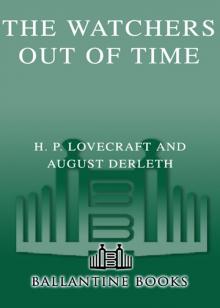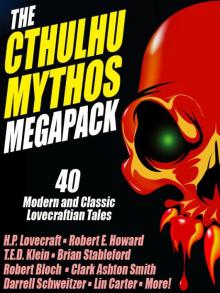- Home
- H. P. Lovecraft
The Cthulhu Mythos Megapack Page 7
The Cthulhu Mythos Megapack Read online
Page 7
We also came upon several star-shaped open spaces, evidently public squares, and noted various undulations in the terrain. Where a sharp hill rose, it was generally hollowed out into some sort of rambling-stone edifice; but there were at least two exceptions. Of these latter, one was too badly weathered to disclose what had been on the jutting eminence, while the other still bore a fantastic conical monument carved out of the solid rock and roughly resembling such things as the well-known Snake Tomb in the ancient valley of Petra.
Flying inland from the mountains, we discovered that the city was not of infinite width, even though its length along the foothills seemed endless. After about thirty miles the grotesque stone buildings began to thin out, and in ten more miles we came to an unbroken waste virtually without signs of sentient artifice. The course of the river beyond the city seemed marked by a broad, depressed line, while the land assumed a somewhat greater ruggedness, seeming to slope slightly upward as it receded in the mist-hazed west.
So far we had made no landing, yet to leave the plateau without an attempt at entering some of the monstrous structures would have been inconceivable. Accordingly, we decided to find a smooth place on the foothills near our navigable pass, there grounding the plane and preparing to do some exploration on foot. Though these gradual slopes were partly covered with a scattering of ruins, low flying soon disclosed an ampler number of possible landing places. Selecting that nearest to the pass, since our flight would be across the great range and back to camp, we succeeded about 12:30 P.M. in effecting a landing on a smooth, hard snow field wholly devoid of obstacles and well adapted to a swift and favorable take-off later on.
It did not seem necessary to protect the plane with a snow banking for so brief a time and in so comfortable an absence of high winds at this level; hence we merely saw that the landing skis were safely lodged, and that the vital parts of the mechanism were guarded against the cold. For our foot journey we discarded the heaviest of our flying furs, and took with us a small outfit consisting of pocket compass, hand camera, light provisions, voluminous notebooks and paper, geologist’s hammer and chisel, specimen bags, coil of climbing rope, and powerful electric torches with extra batteries; this equipment having been carried in the plane on the chance that we might be able to effect a landing, take ground pictures, make drawings and topographical sketches, and obtain rock specimens from some bare slope, outcropping, or mountain cave. Fortunately we had a supply of extra paper to tear up, place in a spare specimen bag, and use on the ancient principle of hare and hounds for marking our course in any interior mazes we might be able to penetrate. This had been brought in case we found some cave system with air quiet enough to allow such a rapid and easy method in place of the usual rock-chipping method of trail blazing.
Walking cautiously downhill over the crusted snow toward the stupendous stone labyrinth that loomed against the opalescent west, we felt almost as keen a sense of imminent marvels as we had felt on approaching the unfathomed mountain pass four hours previously. True, we had become visually familiar with the incredible secret concealed by the barrier peaks; yet the prospect of actually entering primordial walls reared by conscious beings perhaps millions of years ago—before any known race of men could have existed—was none the less awesome and potentially terrible in its implications of cosmic abnormality. Though the thinness of the air at this prodigious altitude made exertion somewhat more difficult than usual, both Danforth and I found ourselves bearing up very well, and felt equal to almost any task which might fall to our lot. It took only a few steps to bring us to a shapeless ruin worn level with the snow, while ten or fifteen rods farther on there was a huge, roofless rampart still complete in its gigantic five-pointed outline and rising to an irregular height of ten or eleven feet. For this latter we headed; and when at last we were actually able to touch its weathered Cyclopean blocks, we felt that we had established an unprecedented and almost blasphemous link with forgotten aeons normally closed to our species.
This rampart, shaped like a star and perhaps three hundred feet from point to point, was built of Jurassic sandstone blocks of irregular size, averaging 6 x 8 feet in surface. There was a row of arched loopholes or windows about four feet wide and five feet high, spaced quite symmetrically along the points of the star and at its inner angles, and with the bottoms about four feet from the glaciated surface. Looking through these, we could see that the masonry was fully five feet thick, that there were no partitions remaining within, and that there were traces of banded carvings or bas-reliefs on the interior walls—facts we had indeed guessed before, when flying low over this rampart and others like it. Though lower parts must have originally existed, all traces of such things were now wholly obscured by the deep layer of ice and snow at this point.
We crawled through one of the windows and vainly tried to decipher the nearly effaced mural designs, but did not attempt to disturb the glaciated floor. Our orientation flights had indicated that many buildings in the city proper were less ice-choked, and that we might perhaps find wholly clear interiors leading down to the true ground level if we entered those structures still roofed at the top. Before we left the rampart we photographed it carefully, and studied its mortarless Cyclopean masonry with complete bewilderment. We wished that Pabodie were present, for his engineering knowledge might have helped us guess how such titanic blocks could have been handled in that unbelievably remote age when the city and its outskirts were built up.
The half-mile walk downhill to the actual city, with the upper wind shrieking vainly and savagely through the skyward peaks in the background, was something of which the smallest details will always remain engraved on my mind. Only in fantastic nightmares could any human beings but Danforth and me conceive such optical effects. Between us and the churning vapors of the west lay that monstrous tangle of dark stone towers, its outre and incredible forms impressing us afresh at every new angle of vision. It was a mirage in solid stone, and were it not for the photographs, I would still doubt that such a thing could be. The general type of masonry was identical with that of the rampart we had examined; but the extravagant shapes which this masonry took in its urban manifestations were past all description.
Even the pictures illustrate only one or two phases of its endless variety, preternatural massiveness, and utterly alien exoticism. There were geometrical forms for which an Euclid would scarcely find a name—cones of all degrees of irregularity and truncation, terraces of every sort of provocative disproportion, shafts with odd bulbous enlargements, broken columns in curious groups, and five-pointed or five-ridged arrangements of mad grotesqueness. As we drew nearer we could see beneath certain transparent parts of the ice sheet, and detect some of the tubular stone bridges that connected the crazily sprinkled structures at various heights. Of orderly streets there seemed to be none, the only broad open swath being a mile to the left, where the ancient river had doubtless flowed through the town into the mountains.
Our field glasses showed the external, horizontal bands of nearly effaced sculptures and dot groups to be very prevalent, and we could half imagine what the city must once have looked like—even though most of the roofs and tower tops had necessarily perished. As a whole, it had been a complex tangle of twisted lanes and alleys, all of them deep canyons, and some little better than tunnels because of the overhanging masonry or overarching bridges. Now, outspread below us, it loomed like a dream fantasy against a westward mist through whose northern end the low, reddish Antarctic sun of early afternoon was struggling to shine; and when, for a moment, that sun encountered a denser obstruction and plunged the scene into temporary shadow, the effect was subtly menacing in a way I can never hope to depict. Even the faint howling and piping of the unfelt wind in the great mountain passes behind us took on a wilder note of purposeful malignity. The last stage of our descent to the town was unusually steep and abrupt, and a rock outcropping at the edge where the grade changed led us to think that an artificial terrace had once existed there. Under the glaciatio
n, we believed, there must be a flight of steps or its equivalent.
When at last we plunged into the town itself, clambering over fallen masonry and shrinking from the oppressive nearness and dwarfing height of omnipresent crumbling and pitted walls, our sensations again became such that I marvel at the amount of self-control we retained. Danforth was frankly jumpy, and began making some offensively irrelevant speculations about the horror at the camp—which I resented all the more because I could not help sharing certain conclusions forced upon us by many features of this morbid survival from nightmare antiquity. The speculations worked on his imagination, too; for in one place—where a debris-littered alley turned a sharp corner—he insisted that he saw faint traces of ground markings which he did not like; whilst elsewhere he stopped to listen to a subtle, imaginary sound from some undefined point—a muffled musical piping, he said, not unlike that of the wind in the mountain caves, yet somehow disturbingly different. The ceaseless five-pointedness of the surrounding architecture and of the few distinguishable mural arabesques had a dimly sinister suggestiveness we could not escape, and gave us a touch of terrible subconscious certainty concerning the primal entities which had reared and dwelt in this unhallowed place.
Nevertheless, our scientific and adventurous souls were not wholly dead, and we mechanically carried out our program of chipping specimens from all the different rock types represented in the masonry. We wished a rather full set in order to draw better conclusions regarding the age of the place. Nothing in the great outer walls seemed to date from later than the Jurassic and Comanchian periods, nor was any piece of stone in the entire place of a greater recency than the Pliocene Age. In stark certainty, we were wandering amidst a death which had reigned at least five hundred thousand years, and in all probability even longer.
As we proceeded through this maze of stone-shadowed twilight we stopped at all available apertures to study interiors and investigate entrance possibilities. Some were above our reach, whilst others led only into ice-choked ruins as unroofed and barren as the rampart on the hill. One, though spacious and inviting, opened on a seemingly bottomless abyss without visible means of descent. Now and then we had a chance to study the petrified wood of a surviving shutter, and were impressed by the fabulous antiquity implied in the still discernible grain. These things had come from Mesozoic gymnosperms and conifers—especially Cretaceous cycads—and from fan palms and early angiosperms of plainly Tertiary date. Nothing definitely later than the Pliocene could be discovered. In the placing of these shutters—whose edges showed the former presence of queer and long-vanished hinges—usage seemed to be varied—some being on the outer and some on the inner side of the deep embrasures. They seemed to have become wedged in place, thus surviving the rusting of their former and probably metallic fixtures and fastenings.
After a time we came across a row of windows—in the bulges of a colossal five-edged cone of undamaged apex—which led into a vast, well-preserved room with stone flooring; but these were too high in the room to permit descent without a rope. We had a rope with us, but did not wish to bother with this twenty-foot drop unless obliged to—especially in this thin plateau air where great demands were made upon the heart action. This enormous room was probably a hall or concourse of some sort, and our electric torches showed bold, distinct, and potentially startling sculptures arranged round the walls in broad, horizontal bands separated by equally broad strips of conventional arabesques. We took careful note of this spot, planning to enter here unless a more easily gained interior were encountered.
Finally, though, we did encounter exactly the opening we wished; an archway about six feet wide and ten feet high, marking the former end of an aerial bridge which had spanned an alley about five feet above the present level of glaciation. These archways, of course, were flush with upper-story floors, and in this case one of the floors still existed. The building thus accessible was a series of rectangular terraces on our left facing westward. That across the alley, where the other archway yawned, was a decrepit cylinder with no windows and with a curious bulge about ten feet above the aperture. It was totally dark inside, and the archway seemed to open on a well of illimitable emptiness.
Heaped debris made the entrance to the vast left-hand building doubly easy, yet for a moment we hesitated before taking advantage of the long-wished chance. For though we had penetrated into this tangle of archaic mystery, it required fresh resolution to carry us actually inside a complete and surviving building of a fabulous elder world whose nature was becoming more and more hideously plain to us. In the end, however, we made the plunge, and scrambled up over the rubble into the gaping embrasure. The floor beyond was of great slate slabs, and seemed to form the outlet of a long, high corridor with sculptured walls.
Observing the many inner archways which led off from it, and realizing the probable complexity of the nest of apartments within, we decided that we must begin our system of hare-and-hound trail blazing. Hitherto our compasses, together with frequent glimpses of the vast mountain range between the towers in our rear, had been enough to prevent our losing our way; but from now on, the artificial substitute would be necessary. Accordingly we reduced our extra paper to shreds of suitable size, placed these in a bag to be carried by Danforth, and prepared to use them as economically as safety would allow. This method would probably gain us immunity from straying, since there did not appear to be any strong air currents inside the primordial masonry. If such should develop, or if our paper supply should give out, we could of course fall back on the more secure though more tedious and retarding method of rock chipping.
Just how extensive a territory we had opened up, it was impossible to guess without a trial. The close and frequent connection of the different buildings made it likely that we might cross from one to another on bridges underneath the ice, except where impeded by local collapses and geologic rifts, for very little glaciation seemed to have entered the massive constructions. Almost all the areas of transparent ice had revealed the submerged windows as tightly shuttered, as if the town had been left in that uniform state until the glacial sheet came to crystallize the lower part for all succeeding time. Indeed, one gained a curious impression that this place had been deliberately closed and deserted in some dim, bygone aeon, rather than overwhelmed by any sudden calamity or even gradual decay. Had the coming of the ice been foreseen, and had a nameless population left en masse to seek a less doomed abode? The precise physiographic conditions attending the formation of the ice sheet at this point would have to wait for later solution. It had not, very plainly, been a grinding drive. Perhaps the pressure of accumulated snows had been responsible, and perhaps some flood from the river, or from the bursting of some ancient glacial dam in the great range, had helped to create the special state now observable. Imagination could conceive almost anything in connection with this place.
VI
It would be cumbrous to give a detailed, consecutive account of our wanderings inside that cavernous, aeon-dead honeycomb of primal masonry—that monstrous lair of elder secrets which now echoed for the first time, after uncounted epochs, to the tread of human feet. This is especially true because so much of the horrible drama and revelation came from a mere study of the omnipresent mural carvings. Our flashlight photographs of those carvings will do much toward proving the truth of what we are now disclosing, and it is lamentable that we had not a larger film supply with us. As it was, we made crude notebook sketches of certain salient features after all our films were used up.
The building which we had entered was one of great size and elaborateness, and gave us an impressive notion of the architecture of that nameless geologic past. The inner partitions were less massive than the outer walls, but on the lower levels were excellently preserved. Labyrinthine complexity, involving curiously irregular difference in floor levels, characterized the entire arrangement; and we should certainly have been lost at the very outset but for the trail of torn paper left behind us. We decided to explore the more decr
epit upper parts first of all, hence climbed aloft in the maze for a distance of some one hundred feet, to where the topmost tier of chambers yawned snowily and ruinously open to the polar sky. Ascent was effected over the steep, transversely ribbed stone ramps or inclined planes which everywhere served in lieu of stairs. The rooms we encountered were of all imaginable shapes and proportions, ranging from five-pointed stars to triangles and perfect cubes. It might be safe to say that their general average was about 30 x 30 feet in floor area, and 20 feet in height, though many larger apartments existed. After thoroughly examining the upper regions and the glacial level, we descended, story by story, into the submerged part, where indeed we soon saw we were in a continuous maze of connected chambers and passages probably leading over unlimited areas outside this particular building. The Cyclopean massiveness and gigantism of everything about us became curiously oppressive; and there was something vaguely but deeply unhuman in all the contours, dimensions, proportions, decorations, and constructional nuances of the blasphemously archaic stonework. We soon realized, from what the carvings revealed, that this monstrous city was many million years old.
We cannot yet explain the engineering principles used in the anomalous balancing and adjustment of the vast rock masses, though the function of the arch was clearly much relied on. The rooms we visited were wholly bare of all portable contents, a circumstance which sustained our belief in the city’s deliberate desertion. The prime decorative feature was the almost universal system of mural sculpture, which tended to run in continuous horizontal bands three feet wide and arranged from floor to ceiling in alternation with bands of equal width given over to geometrical arabesques. There were exceptions to this rule of arrangement, but its preponderance was overwhelming. Often, however, a series of smooth cartouches containing oddly patterned groups of dots would be sunk along one of the arabesque bands.

 The Best of H.P. Lovecraft
The Best of H.P. Lovecraft The Definitive H.P. Lovecraft: 67 Tales Of Horror In One Volume
The Definitive H.P. Lovecraft: 67 Tales Of Horror In One Volume The Complete Works of H.P. Lovecraft
The Complete Works of H.P. Lovecraft Other Gods and More Unearthly Tales
Other Gods and More Unearthly Tales Lovecraft's Fiction Volume I, 1905-1925
Lovecraft's Fiction Volume I, 1905-1925 The Shadow Out of Time
The Shadow Out of Time The Shunned House
The Shunned House Lovecraft's Fiction Volume II, 1926-1928
Lovecraft's Fiction Volume II, 1926-1928 The Thing on the Doorstep and Other Weird Stories
The Thing on the Doorstep and Other Weird Stories Dream Cycle of H. P. Lovecraft: Dreams of Terror and Death
Dream Cycle of H. P. Lovecraft: Dreams of Terror and Death Great Tales of Horror
Great Tales of Horror Shadows of Death
Shadows of Death Delphi Complete Works of H. P. Lovecraft (Illustrated)
Delphi Complete Works of H. P. Lovecraft (Illustrated) Waking Up Screaming: Haunting Tales of Terror
Waking Up Screaming: Haunting Tales of Terror H.P. Lovecraft Goes to the Movies
H.P. Lovecraft Goes to the Movies The Road to Madness
The Road to Madness The Complete H.P. Lovecraft Reader (68 Stories)
The Complete H.P. Lovecraft Reader (68 Stories) The Horror in the Museum
The Horror in the Museum Collected Fiction Volume 1 (1905-1925): A Variorum Edition
Collected Fiction Volume 1 (1905-1925): A Variorum Edition Lovecrafts_Fiction, vol.I_1905-1925
Lovecrafts_Fiction, vol.I_1905-1925 Writings in the United Amateur, 1915-1922
Writings in the United Amateur, 1915-1922 H.P. Lovecraft: The Complete Works
H.P. Lovecraft: The Complete Works Collected Fiction Volume 3 (1931-1936): A Variorum Edition
Collected Fiction Volume 3 (1931-1936): A Variorum Edition H.P. Lovecraft: The Complete Fiction
H.P. Lovecraft: The Complete Fiction Collected Fiction Volume 2 (1926-1930): A Variorum Edition
Collected Fiction Volume 2 (1926-1930): A Variorum Edition Yog Sothothery - The Definitive H.P. Lovecraft Anthology
Yog Sothothery - The Definitive H.P. Lovecraft Anthology The Complete H.P. Lovecraft Collection (Xist Classics)
The Complete H.P. Lovecraft Collection (Xist Classics) The Watchers Out of Time
The Watchers Out of Time Eldritch Tales
Eldritch Tales The Other Gods And More Unearthly Tales
The Other Gods And More Unearthly Tales The New Annotated H. P. Lovecraft
The New Annotated H. P. Lovecraft At the mountains of madness
At the mountains of madness Bloodcurdling Tales of Horror and the Macabre
Bloodcurdling Tales of Horror and the Macabre Fossil Lake II: The Refossiling
Fossil Lake II: The Refossiling Shadows of Carcosa: Tales of Cosmic Horror by Lovecraft, Chambers, Machen, Poe, and Other Masters of the Weird
Shadows of Carcosa: Tales of Cosmic Horror by Lovecraft, Chambers, Machen, Poe, and Other Masters of the Weird H. P. Lovecraft
H. P. Lovecraft The Cthulhu Mythos Megapack
The Cthulhu Mythos Megapack The Complete H. P. Lovecraft Reader (2nd Edition)
The Complete H. P. Lovecraft Reader (2nd Edition) The Complete Fiction
The Complete Fiction Waking Up Screaming
Waking Up Screaming Transition of H. P. Lovecraft
Transition of H. P. Lovecraft![[1935] The Shadow Out of Time Read online](http://i1.bookreadfree.com/i2/04/12/1935_the_shadow_out_of_time_preview.jpg) [1935] The Shadow Out of Time
[1935] The Shadow Out of Time The Horror Megapack
The Horror Megapack